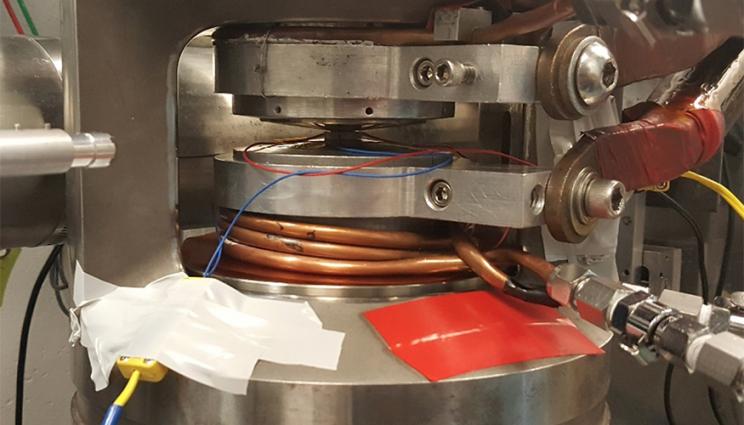
The Paris-Edinburgh-type press with specialized thermoelectric cell assembly situated at the Advanced Photon Source on HPCAT beamline 16-BMB used for these experiments. This apparatus enables measurement of high-pressure/temperature thermal and electric properties of materials.
Researchers have shown how applying pressure to a specific thermoelectric material, TiNiSn, increases its efficiency and leads to a structural phase transition. Thermoelectric materials are materials that can provide energy without the need for mechanical parts by converting heat energy into electrical energy. Thus, research aimed at these materials can identify new, more efficient materials.
The research, which is featured in the Journal of Physical Chemistry Letters, shows that pressure and temperature may enhance the properties and efficiency of thermoelectric materials for better potential use in applications such as waste heat recovery, radio-isotope thermoelectric generators (as used by NASA on space missions) and cooling in computer circuitry.
"Due to the rising global energy demands and the effects on climate, there is an imperative need to find clean, renewable and reliable sources for energy and waste heat recovery," said Jason Baker, Lawrence Livermore National Laboratory physicist and lead author of the paper. "Thermoelectric materials can provide these requirements due to their inherent ability to convert heat energy via a thermal gradient into electrical energy without a reliance on mechanical parts."
Baker helped lead the work while he was at the University of Nevada Las Vegas and with colleagues from Los Alamos National Laboratory and HPCAT at the Advanced Photon Source.
These materials are limited by their efficiency to convert heat into electricity, which is described mathematically by a quantity known as the "dimensionless figure of merit" ZT. The larger this value, the more efficient the material is at this conversion. By performing fundamental scientific research on these materials' electrical and thermal properties at various points in phase space, new structural phases may be identified with improved thermoelectric efficiency.
"Understanding how electrical and thermal properties respond to pressure and temperature leads to a better understanding of these materials and potential predictions of phases and materials to be synthesized and identified," Baker said.
Providing key information for predictions, calculations
The ability to measure electrical and thermal properties such as thermal conductivity at elevated pressure and temperature conditions can provide important input parameters and diagnostics to enhance the prediction and calculation capabilities of equation of state modeling codes. These codes can then feed into hydrodynamic codes and other high-level simulations at extreme conditions. This type of research provides a potentially powerful technique that is applicable to materials other than thermoelectric materials, including high explosives (HE) and radioactive compounds.
Baker explained that the structural, electrical and thermal properties of materials can change dramatically as a function of phase variables such as pressure and temperature. Examples of these changes are materials becoming superconducting by lowering the temperature - and sometimes applying pressure - and the transition from graphite to diamond through application of pressure and temperature. Thus, pressure and temperature are valuable, tunable variables that can potentially change the properties of these materials (thermoelectrics) favorably.
Chemical doping and substitution is a key method to tune the electrical and thermal properties of thermoelectric materials. These direct changes to the chemistry of materials induces new electronic structures and thus new properties. Pressure can be used to mimic these electronic structure changes, and thus can be a tool to identify potential chemical pathways for materials.
Measurement of electrical and thermal properties of materials is important not only to thermoelectric materials, but also to a wide-range of materials and applications, and techniques such as those employed in this research are generally applicable.
Work conducted in two parts
The first part of research was conducted by using the synchrotron X-ray powder diffraction. This was used to probe the structural properties of the material in combination with diamond anvil cells (DACs), which provided pressures up to 50 GPa. The second part of the research used the electrical resistance, Seebeck coefficient. As part of this, thermal conductivity was measured as a function of pressure (1 to 3.5 GPa) at slightly elevated temperatures (325 K) using a specially designed sample cell assembly for the Paris-Edinburg-type press (previously designed and published by the team).
Some of the key findings were that this material underwent a phase transition at high-pressure and with relatively small amounts of pressure, an increase in thermoelectric efficiency was identified.
The theory/simulation portion of this work was conducted using a few methods. Density function theory calculations were performed to calculate the structural properties. (PAW method as implemented in VASP package). The electronic structure properties were calculated using a self-consistent FP-LAPW method implemented in WIEN2k package. Structure searching calculations were performed using ab initio random searching (AIRSS) in combination with CASTEP code.
The identification of the high-pressure structure was highly dependent on the structure searching calculations performed, which was able to identify the structure. The experimental data was then compared to this specific structure.
Baker served as lead author in the research. Co-authors include Changyong Park, Curtis Kenney-Benson, Vineet Kumar Sharma, V. Kanchana, Ganapathy Vaitheeswaran, Christopher Pickard, Andrew Cornelius, Nenad Velisavljevic and Ravhi Kumar.






